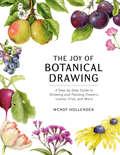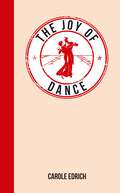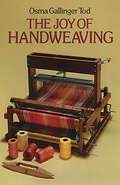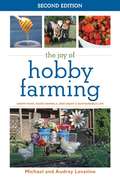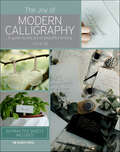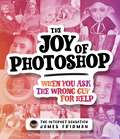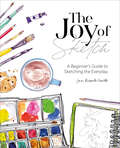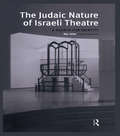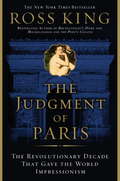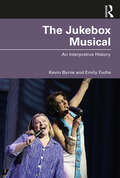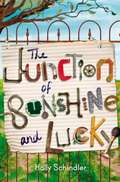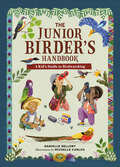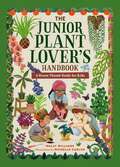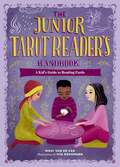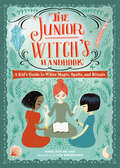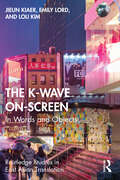- Table View
- List View
The Joy of Botanical Drawing: A Step-by-Step Guide to Drawing and Painting Flowers, Leaves, Fruit, and More
by Wendy HollenderA gorgeous, easy-to-follow, and inspiring guide to stunningly realistic botanical drawing that covers everything you need to draw our natural world.Achieve amazingly realistic and vibrant botanical illustrations, from flowers so dazzling you feel as if you might be able to smell them, to tomatoes that look as if they've just been picked from the garden. Wendy Hollender is known for her vivid, detailed, and inspiring illustrations and in The Joy of Botanical Drawing, she helps you take your art to the next level by sharing her perfected techniques through short lessons that start simple, then build on the basics with easy-to-use and clear step-by-step illustrations. Using colored pencils and watercolor pencils, Hollender shows you how to accomplish scientifically accurate botanical portraits of a spiraling pine cone, a spiky chestnut, a fuchsia-tined radish, a graceful morning glory, and many more.From colorful leaves to delicate petals to textured bark and slender stems, The Joy of Botanical Drawing will give you the skills to complete lifelike drawings while also enjoying nature and the mindfulness of a regular drawing practice.
The Joy of Camping: For Those Who Love the Great Outdoors (The\joy Of Ser.)
by Phoebe SmithThis pocket-sized miscellany, packed with tips on equipment, food, surviving bad weather and finding the right campsite, and with facts and stories from the world of camping, is perfect for anyone who knows the incomparable joy and adventure of pitching their tent under an open sky.
The Joy of Camping: For Those Who Love the Great Outdoors (The\joy Of Ser.)
by Phoebe SmithThis pocket-sized miscellany, packed with tips on equipment, food, surviving bad weather and finding the right campsite, and with facts and stories from the world of camping, is perfect for anyone who knows the incomparable joy and adventure of pitching their tent under an open sky.
The Joy of Dance: For Those Who Have Rhythm in Their Feet (The\joy Of Ser.)
by Carole EdrichThis pocket-sized miscellany, packed with fascinating facts, captivating stories and inspiring quotes from the world of dance, is perfect for anyone who knows the incomparable joy and freedom of slipping on your dance shoes and expressing yourself through movement to music.
The Joy of Dance: For Those Who Have Rhythm in Their Feet (The\joy Of Ser.)
by Carole EdrichThis pocket-sized miscellany, packed with fascinating facts, captivating stories and inspiring quotes from the world of dance, is perfect for anyone who knows the incomparable joy and freedom of slipping on your dance shoes and expressing yourself through movement to music.
The Joy of Decorating: Southern Style with Mrs. Howard
by Phoebe HowardThe beloved design maven peppers her first book “with tips for achieving a romantic, delicate look without being twee or overly saccharine” (Veranda).Phoebe Howard, known affectionately as Mrs. Howard to her clients, has a penchant for creating stylish spaces, which has evolved into her own critically acclaimed brand of interior design. Mrs. Howard’s first book features several of her largest design projects and addresses the most common decorating issues and questions her clients and customers ask. The book’s design projects are organized by theme: Inviting, Inspiring, Timeless, Graceful, Tranquil, Casual, and Comfortable—all words that have been used to describe Mrs. Howard’s work and ones that illustrate the many different ways she strives to make her houses look and feel.Cowritten with well-known Southern writer Susan Sully, this gorgeous book epitomizes the grace and elegance of Southern interior design.“A handsome new book . . . Howard, FYI, is one Phoebe Howard in real life, a self-made decorator known for elegantly traditional, genteel Southern rooms.” —The Dallas Morning News“Guaranteed to inspire your own imagination.” —Atlanta“It never disappoints! Every room, project and vignette featured are beautiful but there are a few images that are simply perfect in my book—timeless and cozy, layered, inviting and lived-in.” —Café Design“Known for her fresh take on traditional style, Phoebe’s work can only be characterized by its timelessness and her mantra to ‘keep it pretty.’ Her work is encapsulated in her first book.” —Women’s Business Daily
The Joy of Handweaving
by Osma TodThis is the first paperback edition of a manual well known to weavers for its great thoroughness, clarity, and value to beginning and professional weavers alike. The author has drawn upon many years of experience as a teacher and writer in preparing this practical text of basic weaving techniques and projects from the simplest to the extremely complex.Each topic of weaving theory and technique is presented with its practical applications in mind. Within the first thirty pages, readers learn enough to complete their first weaving project, a bookmark, and this leads directly to the weaving of rugs on a loom, the process of weaving on a two-harness loom, threading plain weave from a draft, making a two-harness table loom (readers following the clear diagram and instructions will have no trouble building the loom), preparing the weft, handling of threads, two-harness design methods, the weaving of rag rugs in plain weave, useful articles woven with striped warps and wefts, tapestry techniques, and design weaves.For advanced weavers, the second major section of the book covers a great variety of weaves for the four-harness loom and related information: how to warp and thread a four-harness loom, weaving both plain and pattern weave, the twill family of weaves and herringbone variations, the principles of overshot pattern weaving, the diamond or cross family, the monk's belt pattern and its uses, practical overshot patterns, designing drafts and special techniques, ways of weaving overshot, special four-harness techniques (summer and winter weave, the Bronson weave, the M's and O's weave, the crackle weave, the waffle weave, matta technique, syncopation, double weaving on a four-harness loom).The author then details multi-harness weaves such as multi-harness twill, eight-harness damask design, and several others. Then follow discussions of the uses of color in weaving designs, planning borders, the various draft notations (European and American), weaving with synthetic fibers, thread sizes, counts and yardage, and costs of handwoven fabrics. There is a thread chart of warp settings and suitable wefts. A final chapter gives instructions for making several projects from hand-woven fabrics (a folder for linens, a small ornamental box, jackets and suits, and others). The text is fully illustrated throughout with photographs and labelled diagrams.
The Joy of Hobby Farming: Grow Food, Raise Animals, and Enjoy a Sustainable Life (Joy of Series)
by Michael Levatino Audrey LevatinoWhen the farm is a lifestyle, but not quite a way to earn a living, it’s considered hobby farming. Most of us want to live a sustainable and healthy life in which we protect the environment and keep it safe from development and overproduction. But we can take this a step further by learning how to grow our own produce, while still maintaining an alternative, successful career to fund this passion. In this back to basics guide, Michael and Audrey Levatino share how to:Grow your own foodRaise chickens, horses, llamas, bees, and morePractice being (a little) off the gridSell the bounty in your local communityBalance a professional career with a rural lifestyleThe Joy of Hobby Farming is a guide that will excite armchair farmers and inspire any do-it-yourselfer. While this book won’t help you become a farmer by trade, it does provide step-by-step instructions and various tips and tricks to maintain a thriving farm. It will surely teach those who aren’t farmers by day to raise their own livestock, plant their own fruits and vegetables, and live out their countryside dream.
The Joy of Hygge: How to Bring Everyday Pleasure and Danish Coziness into Your Life
by Jonny Jackson Elias LarsenHygge (pronounced “hoo-gah”) is a Danish word that describes the feeling of being cozy, comfortable, and at peace with the world. It’s almost impossible to translate to English, and it’s probably the reason that Denmark is one of the happiest countries in the world.According to the London Evening Standard, hygge takes us beyond mindful meditation and adult coloring books and introduces us to a comfortable, warm, relaxing lifestyle exemplified by those in Denmark.The Joy of Hygge is packed with recipes to warm you on a winter’s evening, craft ideas for decorating your home, and inspirational suggestions for enjoying the magic of everyday pleasures. Learn how to make your life more hyggelig by: •Creating a snuggly pair of hand-knitted socks •Filling your house with more light and nature displays •Building a cozy campfire for friends and family •Taking advantage of picnics, bike rides, and woodland walks •Appreciating the natural wonders that surround us every day •And more! Remember—a little hygge brings a lot of happiness.
The Joy of Modern Calligraphy: A Guide to the Art of Beautiful Writing
by Joyce LeeA complete guide to modern calligraphy with Artsynibs.Joyce Lee first picked up a calligraphy pen when she started making stationery for her wedding. For her, it is now a way of life, her career and what she calls a 'calligraventure'.In this practical and inspiring book, Joyce introduces modern calligraphy, including the tools you need and how to use them. She teaches various techniques and methods for creating beautiful artwork to give you the confidence to embark on creative projects of your own, including handwritten envelopes, gift tags and an elegant monogram.To help you practise your handwriting skills, the book is accompanied by an envelope of photocopiable practice sheets, contained within an attractive hardback folder. However, this is more than just an instructional guide; it encourages you to find joy in committing your thoughts to paper. Joyce believes that calligraphy is not just about perfecting the strokes, but about patience, concentration and slowing down to be mindful of the moment. Creativity is at the heart of us all; it simply needs to be unlocked, nurtured and given an outlet.This book is everything calligraphy should be: classic, stylish, creative and thought-provoking. Fall in love with the art of handwritten lettering as you release your own creativity on the page.
The Joy of Photoshop: When You Ask The Wrong Guy For Help
by James FridmanThe Joy of Photoshop is the long-awaited book from the social media sensation James Fridman.Have you ever taken a seemingly perfect picture only to have it ruined by one tiny detail? Photoshop master James Fridman is only too happy to help, even if he sometimes takes requests a little too literally.The Joy of Photoshop contains James's best-loved and funniest image alterations. From the woman who wished to look like a mermaid, to super-fans who want to be edited into their favourite movies, his followers never get quite what they asked for. Including plenty of never-before-seen pictures, this meme-tastic book will have you in stitches!
The Joy of Photoshop: When You Ask The Wrong Guy For Help
by James FridmanThe Joy of Photoshop is the long-awaited book from the social media sensation James Fridman.Have you ever taken a seemingly perfect picture only to have it ruined by one tiny detail? Photoshop master James Fridman is only too happy to help, even if he sometimes takes requests a little too literally.The Joy of Photoshop contains James's best-loved and funniest image alterations. From the woman who wished to look like a mermaid, to super-fans who want to be edited into their favourite movies, his followers never get quite what they asked for. Including plenty of never-before-seen pictures, this meme-tastic book will have you in stitches!
The Joy of Sketch: A Beginner's Guide to Sketching the Everyday
by Jen Russell-SmithUsing simple exercises, rediscover the pleasure you got from childhood drawing, before you became too self-conscious and self-critical to enjoy it. As we grow up, somehow we learn that drawing is hard and there are all sorts of rules about colour and perspective that stifle our creativity. This book is here to remind you of the joy you once found in creating, scribbling, getting something down on paper—and that it&’s more about the process than the result. This accessible guide takes you by the hand, breaks down the barriers to sketching, and shows you how to build your confidence and skills to draw spontaneously, with nothing more than the things around you for inspiration. Through a series of simple exercises, you will learn how to sketch everyday items, people and places, using simple watercolour techniques to add colour to your sketchbooks.
The Joy of Sox
by Linda KoppSox rocks! Here comes the hottest collection of knitted socks yet, filled with 30-plus designs, a variety of techniques, tips, and playful trivia from those in the know. And it’s all in one flirtatiously fresh package. Aimed at the knitter who is super-passionate about socks, The Joy of Sox delivers on its name. With their tantalizing cables, intricate lacework, and intriguing color work, the patterns represent the very best in sock design. There are revamped classics, bold new styles, and even a few themed socks—like the diamond lace thigh-highs and toeless pedicure socks. In addition to the results of our online knitting poll, you’ll also get fun stuff, including info from knitting personality Laurie Perry and phenoms Laura Bryant and Shannon Okey.
The Joy of Swimming: A Celebration of Our Love for Getting in the Water (Lisa Congdon X Chronicle Bks.)
by Lisa Congdon Lynn CoxFrom Lisa Congdon, bestselling author of Whatever You Are, Be a Good One, this lovely new book invites readers to dip into the many joys of swimming. Congdon brings her personal passion as a lifelong swimmer to this beautiful and thoughtful celebration of getting in the water. Hand-lettered inspirational quotes, watercolor portraits paired with real people's personal stories, illustrated collections of vintage objects--colorful swim caps, bathing suits through the ages, traditional pool signs--and much more evoke the beauty and inspiration of the subject. An emphasis on swimming as a way of life--taking the leap, going with the flow--makes this delightful volume one that will speak to serious swimmers, vacation paddlers, and anyone pondering their next high dive.
The Joy of Watercolor: 40 Happy Lessons for Painting the World Around You
by Emma BlockEnjoy the meditative art of watercolor with simple supplies and easy-to-follow instructions!For a soothing boost of creativity and whimsy, try your hand at watercolor. With a few simple steps, anyone can discover their artistic side, and achieve moments of peace and tranquility doing so. Forty straightforward lessons promise fun and colorful results: no previous artistic skill required. This simple painting medium produces colorful, modern paintings to adorn invitations, gifts, and walls. The 40 lessons cover useful topics like: painting on vacation painting your pets layering colors mixing colors painting flowers and plantsSupplies are minimal: a basic palette of watercolors and a selection of brushes, plus nice thick paper, will do the job, yielding bright and whimsical results guaranteed to bring color to any gray day. Painting your own beautiful cards and artwork is within reach!
The Judaic Nature of Israeli Theatre: A Search for Identity (Contemporary Theatre Studies #Vol. 31.)
by Dan UrianTheatre has, since the time of the Jewish Enlightenment, served the secular community in its conflict with the religious. This book surveys the secular-religious rift and then describes the enhanced concern of the secular community in Israel for its own Jewishness and its expression in the theatre - especially following the 1967 War. It then moves on to a specific study of the play Bruira and finally reviews the phenomenon of the return to Orthodox Judaism by secular individuals.
The Judgment of Paris: The Revolutionary Decade That Gave the World Impressionism
by Ross KingThe fascinating new book by the author of Brunelleschi's Dome and Michelangelo and the Pope's Ceiling: a saga of artistic rivalry and cultural upheaval in the decade leading to the birth of Impressionism.If there were two men who were absolutely central to artistic life in France in the second half of the nineteenth century, they were Edouard Manet and Ernest Meissonier. While the former has been labelled the "Father of Impressionism" and is today a household name, the latter has sunk into obscurity. It is difficult now to believe that in 1864, when this story begins, it was Meissonier who was considered the greatest French artist alive and who received astronomical sums for his work, while Manet was derided for his messy paintings of ordinary people and had great difficulty getting any of his work accepted at the all-important annual Paris Salon. Manet and Meissonier were the Mozart and Salieri of their day, one a dangerous challenge to the establishment, the other beloved by rulers and the public alike for his painstakingly meticulous oil paintings of historical subjects. Out of the fascinating story of their parallel careers, Ross King creates a lens through which to view the political tensions that dogged Louis-Napoleon during the Second Empire, his ignominious downfall, and the bloody Paris Commune of 1871. At the same time, King paints a wonderfully detailed and vivid portrait of life in an era of radical social change: on the streets of Paris, at the new seaside resorts of Boulogne and Trouville, and at the race courses and picnic spots where the new bourgeoisie relaxed. When Manet painted Dejeuner sur l'herbe or Olympia, he shocked not only with his casual brushstrokes (described by some as applied by a 'floor mop') but with his subject matter: top-hatted white-collar workers (and their mistresses) were not considered suitable subjects for 'Art'. Ross King shows how, benign as they might seem today, these paintings changed the course of history. The struggle between Meissonier and Manet to see their paintings achieve pride of place at the Salon was not just about artistic competitiveness, it was about how to see the world.Full of fantastic tidbits of information (such as the use of carrier pigeons and hot-air balloons during the siege of Paris), and a colourful cast of characters that includes Baudelaire, Courbet, and Zola, with walk-on parts for Monet, Renoir, Degas, and Cezanne, The Judgment of Paris casts new light on the birth of Impressionism and takes us to the heart of a time in which the modern French identity was being forged.
The Jukebox Musical: An Interpretive History
by Kevin Byrne Emily FuchsThis is a comprehensive guide to the unique genre of the jukebox musical, delving into its history to explain why these musicals have quickly become beloved for multiple generations of theatergoers and practitioners. Providing a concise exploration of the three main categories of the jukebox musical—biographical, genre-specific, and artist catalog—this text is perfect for those wishing to learn more about this relatively recent and unique genre of theater. It identifies the dramaturgical needs that arise in these productions and explains how certain works become critical darlings or fan favorites. How much information needs to be conveyed through song and how much can be left up to interpretation by the audience? What kinds of changes occur when a repertoire of songs is reimagined for the stage? In addition to these insightful explorations, it also reveals how creative teams tackle the unique challenge of weaving together plot and song in order to convey meaning, emotion, excitement, and beauty in these increasingly popular forms of theater. The Jukebox Musical: An Interpretive History is written for students, performers, and musical theater enthusiasts alike: this is the ideal introduction to one of the twnty-first century's most popular and successful stage genres.
The Junction of Sunshine and Lucky
by Holly Schindler"Beasts of the Southern Wild" meets Because of Winn Dixie in this inspiring story of hope. August "Auggie" Jones lives with her Grandpa Gus, a trash hauler, in a poor part of town. So when her wealthy classmate's father starts the House Beautification Committee, it's homes like Auggie's that are deemed "in violation." Auggie is determined to prove that she is not as run-down as the outside of her house might suggest. Using the kind of items Gus usually hauls to the scrap heap, a broken toaster becomes a flower; church windows turn into a rainbow walkway; and an old car gets new life as spinning whirligigs. What starts out as a home renovation project becomes much more as Auggie and her grandpa discover a talent they never knew they had--and redefine a whole town's perception of beauty, one recycled sculpture at a time. Auggie's talent for creating found art will remind readers that one girl's trash really is another girl's treasure.
The Junior Birder's Handbook: A Kid's Guide to Birdwatching (The Junior Handbook Series)
by Danielle BellenyA beautifully illustrated kid's guide to birds and their habitats, perfect for budding birders whether you live in a city, suburb, or rural area. In the woods, in cities, in your backyard—birds are everywhere. But do you know the difference between a robin and a wren? A raven and a crow? In this fully illustrated book, you will learn how to identify birds in an array of habitats and seasons (thanks to migration, there are always new birds to find). You'll also learn the different behaviors/habits of birds—from why blue jays divebomb other birds&’ nests to what attracts hummingbirds to certain flowers. As the popularity of birding and birdwatching reach new heights, more and more children have the opportunity to connect with nature, whether indoors or outside and with no equipment other than one&’s eyes (and this handbook, of course). What&’s not to love? Featuring Michelle Carlos's vibrant illustrations, this gorgeous (and gifty) book includes interactive elements like quizzes and crafts, as well as accessible charts/guides that will lead to endless fun!
The Junior Plant Lover's Handbook: A Green-Thumb Guide for Kids (The Junior Handbook Series)
by Molly WilliamsAn interactive, illustrated guide perfect for any burgeoning plant lover! Research shows plants can keep us (and our living spaces) happier and healthier. This illustrated guide breaks down everything from basic light and water needs to soil and temperature requirements for over fifty plants, and will help you find the right plant(s) for your personality, regardless of where you live or how much space you have. With an expansive glossary of plant terms, you&’ll be speaking like a horticulture pro in no time. Each section includes: &“How To&” instructions for planting and caring for greenery Fun plant facts Troubleshooting tips Interactive quizzes Informative, handy charts DIY crafts and projects
The Junior Tarot Reader's Handbook: A Kid's Guide to Reading Cards (The Junior Handbook Series)
by Nikki Van De CarLearn how to read tarot cards and understand what the past, present, and future have to say about your life, especially as it pertains to friendships, family, and school. From Nikki Van De Car, author of The Junior Witch&’s Handbook and The Junior Astrologer&’s Handbook, this third book in the Junior Handbook series teaches young readers how to use tarot to get answers to questions about life, friendships, family, school, and more. The book offers a step-by-step guide to everything from how to choose a deck to how to do a reading and includes detailed explanations of what each card in a tarot deck represents and how to apply these meanings to your own life. Maybe you need to focus more at school or examine how you've been treating your friends. Perhaps you simply need more love and support from family. Whatever the need, whatever the question, let the cards be a source of wisdom in how to handle anything that comes your way. With beautiful illustrations from Uta Krogmann, this is an empowering guide of self-discovery. Whether reading on your own or with friends, The Junior Tarot Reader's Handbook is the perfect guide for budding mystics.
The Junior Witch's Handbook: A Kid's Guide to White Magic, Spells, and Rituals (The Junior Handbook Series)
by Nikki Van De CarAn empowering guide for young witches about the kinds of magic they can create for themselves every day.Intended for children between the ages of eight and twelve, who are curious about the possibility of "something more" in their lives, this handbook focuses on three major areas of the witch's life: friendship, personal fulfillment, and family. Each section includes spells, rituals, potions, and other useful information, such as tables about crystals, chakras, and herbs.
The K-Wave On-Screen: In Words and Objects (Routledge Studies in East Asian Translation)
by Jieun Kiaer Loli Kim Emily LordThe K-Wave On-Screen provides an engaging and accessible exploration of the meaning of ‘K-’ through the lens of words and objects in K-dramas and K-films. Once a small subculture known only to South Korea’s East Asian neighbours, the Korean Wave has exploded in popularity around the globe in the last decade. Its success has been fuelled by social media and the advanced technological capabilities of South Korea. With #KpopTwitter having amassed 7.8 billion tweets and with K-films receiving acclaim from major award ceremonies, the K-wave is now a global cultural phenomenon. This book touches on globally popular productions, such as Parasite (2019), Squid Game (2021), Pachinko (2022), SKY Castle (2018), and Kim Ji-young: Born 1982 (2019) to highlight that K- has departed from the traditional meaning of ‘Korean-ness’ to become a new, globally-informed, and hybrid entity. This book will be of interest to students in East Asian studies, and those engaged with Korean language learning. The book will also appeal to those interested in Korean culture and media.
